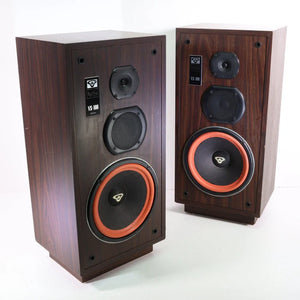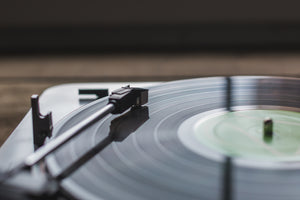We are unable to reply to comments, so please message us directly if you have a specific question regarding products, shipping costs, etc. Our office number is (480) 207-1511. Our email is hello@spencertified.com. You can also message us on Facebook. Commonly asked questions and answers can be found on our FAQs page here.

OUTCLASS THEM WITH THE YAMAHA CR-820!
THIS CLASSIC RECEIVER IS AN EASY CHOICE IN THE REALM OF VINTAGE AUDIO GEAR
Vintage? Check. High-quality? Check. Excellent sensitivity, low distortion, and high-output power? Check, check, and check.
Yamaha receivers from the 70s and 80s don’t receive the same recognition and love as other names like Marantz, Sansui, and Pioneer. But depending on the model, they can be on par quality-wise with these kings - and look just as good doing it.
The CR-820 in particular illustrates why Yamaha’s vintage gear is some of the best. The CR-820 is loaded with features and specs that are capable of making even the most discerning of vintage lovers drool.
REAL LIFE RATED

First off, the Yamaha CR-820 is an incredibly well-built receiver. It offers 55 watts per channel into 8 ohms with a low distortion rate of 0.02%. Plus, Yamaha used something they call NDCR (Noise Distortion Clearance Range) for this measurement. While most manufacturers measured harmonic distortion at the rated output of the unit, Yamaha measured it over a wide range of power output.
Specifically, they measured noise and distortion at -20dB from every input all the way through to the speaker output (as opposed to just measuring the amp section). This was to give buyers a more accurate indication of performance in a true listening environment, leading Yamaha to trademark the phrase “Real Life Rated” in the process.
Then when you throw in a dash of OTS (Optimum Tuning System) to maintain minimum distortion and maximum stereo separation along with a cup of Continuous Loudness Compensation for the best audio clarity possible no matter your normal maximum listening level, you’re left with a machine that takes quality to a whole new level.
FRONT PANEL
Whether you’re a newbie to the world of 70s and 80s audio or you’re a practiced hand at vintage receivers, nothing beats that classic silver front panel with that glorious combination of knobs, buttons, and switches. And in this respect, the CR-820 certainly does not disappoint.
It has clean, oversized controls for bass, presence, treble, loudness, volume/balance, and tuning. It has oversized switches for the rec out selector and the input selector as well. There are also a series of push buttons along the bottom of the unit for speaker switching, low filter/high filter, mode (stereo or mono), FM muting, tuner switching, phono switching, and audio muting.
At the top of the front panel rests a really nice twin-meter: both signal strength and center-zero FM tuning meters are provided with the signal strength meter doubling as a signal quality meter. And, of course, the FM/AM tuning scale with LEDs indicating which scale is in use.
REAR PANEL
The rear panel has all your basic goodies: FM and AM antenna connections to listen to your favorite radio stations, a GND terminal to ground your turntable, two sets of speaker terminals to connect two pairs of speakers, and three AC outlets (one switched and two unswitched) to power the rest of your system. Switched means that the power is controlled by the receiver while unswitched will continue to receive power even if the receiver is turned off.
It’s also loaded with all of the needed input terminals to connect it to the rest of your vintage audio gear. This includes dual phono jacks (how cool would it be to hook up not one but two turntables?), an auxiliary input for a component such as an 8-track player, and two tape inputs for connecting two tape decks. It also has two tape outputs for recording, which is great for easily duplicating tapes or for creating two recordings at once (recordings of any source connected to the CR820 can even be made on both decks at the same time).
SPECIFICATIONS
- Tuning range: FM, MW
- Power output: 50 watts per channel into 8Ω (stereo)
- Frequency response: 20Hz to 20kHz
- Total harmonic distortion: 0.02%
- Damping factor: 40
- Input sensitivity: 2mV (MM), 120mV (DIN), 120mV (line)
- Signal to noise ratio: 78dB (MM), 97dB (line)
- Output: 120mV (line), 30mV (DIN)
- Speaker load impedance: 4Ω (minimum)
- Dimensions: 20.75″ x 15.5″ x 6.7″ (Length x Width x Height)
- Weight: 42 lbs
- Manufactured: 1977 in Taiwan
IN SUMMARY
The CR-820 falls into Yamaha’s CR-XX20 line of receivers, which are reliable, well-built, and capable of surviving an age. They also are more easily repaired thanks to their use of discrete transistors (as opposed to the STK parts used in their CR-XX40 line), which is an important factor when considering vintage equipment.
Vintage pieces like the Yamaha CR820 are also getting more difficult to find. Not as many Yamahas were sold compared to, say, Pioneer receivers of the same decade, making these machines that much more wonderful to own. And if you are looking to invest in the CR-820, you’re in luck! We currently have a working one on sale here.
Thanks for reading! Have a great day.
https://spencertified.com/products/pioneer-cr-820-vintage-am-fm-stereo-receiver-silver-face-1977?_pos=1&_sid=b3443bd52&_ss=r








Comments
Leave a comment